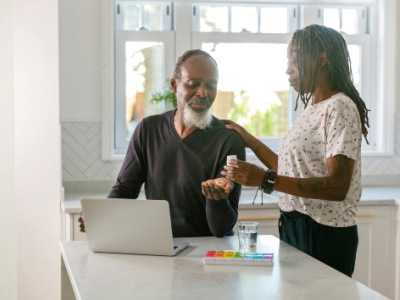Smartphones, tablets, and other devices make it simple to read, watch, and share health information. But the convenience comes with a big trade-off. The internet is filled with misleading and false information. How can you tell the difference between content that is credible and content that isn’t?
About Health Misinformation
Health misinformation, according to the Journal of Medical Internet Research, is a "health-related claim that is based on anecdotal, false, or misleading evidence." Many healthcare professionals agree health misinformation can be dangerous; getting misleading or incorrect information about a chronic condition or a medication can have serious repercussions.
“A lot of websites that post misinformation look like trustworthy sources. They look just like news sites or health sites. That makes it difficult to distinguish reliable information from unreliable information,” said Dr. Yotam Ophir, an assistant professor of communications at the University of Buffalo.
How Big Is the Problem?
“In our digital age, [fake news] can spread like wildfire. When that happens, it can fuel skepticism, distrust, fear, and anxiety,” said Dr. Teresa Wagner, an assistant professor at the School of Health Professions at the University of North Texas Health Science Center and a clinical executive at SaferCare Texas, which focuses on patient safety and communication.
According to the U.S. Surgeon General Dr. Vivek Murthy, “Health misinformation is a serious threat to public health. It can cause confusion, mistrust, harm people’s health, and undermine public health efforts.” He released a Community Toolkit for Addressing Health Misinformation to help Americans navigate the serious threat of health misinformation, especially online.
Resources in the Community Toolkit include:
- A Health Misinformation Checklist to help evaluate the accuracy of health-related content
- Tips on how individuals can talk to loved ones about health misinformation
- An outline of common types of misinformation and disinformation tactics
- Reflections and examples of times individuals may have encountered misinformation
How to Surf the Internet Like a Scientist
The tips below won’t stop fake news from filling your social media feeds but can help you spot it and avoid it.
- Start with yourself. Focus on your goals before searching for health information. If you want to find information on a topic, avoid adjectives like “good” or “bad” and instead focus on the five W’s and H (who, what where, when, why, and how) to get clear answers to your questions.
- Read past the headlines. Website creators are competing for your attention and might use a misleading headline to get you to click. In many cases, the content may not match the headline so be sure to read the full article or watch the video.
- Beware of ‘miracle cures.’ No treatment, medication, or vaccine is 100% effective. If the content you are viewing promotes something as a ‘revelation’ or ‘miracle cure,’ consider it suspicious.
- Consider the source. Even articles from seemingly trustworthy websites or news outlets may publish misleading information. First off, check the date. If you are reading health information that is more than three to five years old, look for more recent sources. Second, make sure information comes from a primary source or links to a primary source, such as research from a medical journal.
- Think before you share. It’s always good to pause before hitting the share button on any information. Make sure you’ve gone through the above steps to ensure this piece of information is both valuable and factual before sharing with friends and family.
Additional Information:
- Health Misinformation and the Integrity of Data—What Is the Role of HI Professionals? (Journal of AHIMA)
- Confronting Health Misinformation (HHS.gov)
- How to Address COVID-19 Vaccine Misinformation (CDC.gov)
- Addressing Health Misinformation with Health Literacy Strategies (National Library of Medicine)
- Health Information vs. Misinformation: How to Tell the Difference (MultiCare Vitals)
- The News Literacy Project offers several free resources for the public, including an e-learning platform, an app, a new podcast, shareable tips, tools, quizzes, and an annual news literacy event.
Over 70% of people have been exposed to medical or health-related misinformation, according to a 2022 survey from GoodRx.






